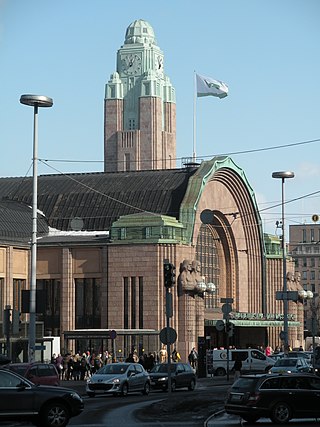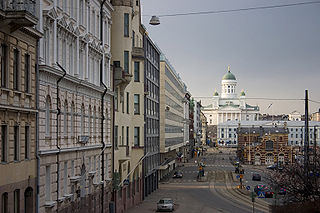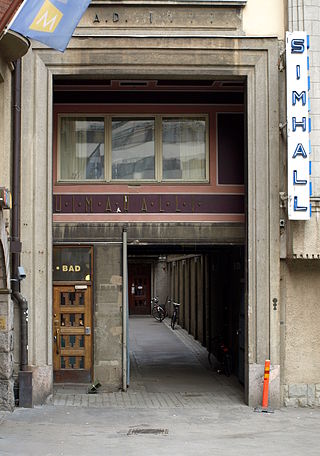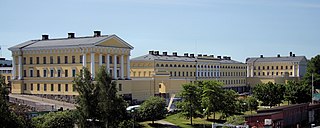
The Rikhardinkatu library is a public library in Kaartinkaupunki, Helsinki, Finland.

The Rikhardinkatu library is a public library in Kaartinkaupunki, Helsinki, Finland.
The library building, representing the Renaissance Revival architecture, was designed by Finnish architect Theodor Höijer and was built in 1881 as the first building in the Nordic countries designed as a general library. [1] Later, in the 1920s, an additional floor designed by architect Runar Eklund and a wing building known as the book tower were added to the inner courtyard. The library served as Helsinki's main library until 1986.
When Helsinki's new main library was opened in Itä-Pasila, renovation work lasting two years was started at the Rikhardinkatu library. The renovation, planned by professor Olof Hansson, sought to return the building's original style. The second phase of the renovation was completed in 2003, when the new Internet room and the salon of the reading hall were taken into use. New premises for music were also opened. [1]
The library premises have also hosted the Art Association of Finland and the Finnish Society of Sciences and Letters.
At the 1882 meeting of the Diet of Finland, the common estates of Finland met at the freshly completed library building. [2] There is a plaque mentioning this at the second floor of the library.

Katajanokka is a neighbourhood of Helsinki, Finland, with around 4000 inhabitants in 2005. The district is located adjacent to the immediate downtown area, though in the first major town plan for Helsinki from the mid-18th century, the area fell outside the fortifications planned to encircle the city.

Helsinki Central Station (HEC) is the main station for commuter rail and long-distance trains departing from Helsinki, Finland. About 200,000 people "pass through the station" every day, half of whom are train passengers. The station serves as the terminus for all trains in the Helsinki commuter rail network, as well as for all Helsinki-bound long-distance trains in Finland. The Rautatientori metro station is located in the same building.

Stockmann Helsinki Centre is a culturally significant business building and department store located in the centre of Helsinki, Finland. It is one of many department stores owned by the Stockmann corporation. It is the largest department store in the Nordic countries in terms of area and total sales. The store is known for carrying all the internationally recognised luxury brands, and Stockmann's enjoys a reputation as the primary high-end department store in Finland. Stockmann Delicatessen, the food and beverage department located at the basement level, is renowned for the quality and choice of its foodstuffs. The Stockmann logo represents a set of escalators, which are commonly, but wrongly believed represent the first escalators in Finland. The first escalators in Finland were installed in the Forum department store, Turku (1926).

Leppävaara is a district of Espoo, a city in Finland. The Rantarata rail line and the Ring Road I, the busiest road in Finland, cross in Leppävaara, thus making it a major traffic hub in the Greater Helsinki region. The Sello Shopping Centre is also located in Leppävaara.

Vartiovuori Observatory is a former observatory in Turku, Finland. The observatory, designed by Carl Ludvig Engel, was originally built for the Royal Academy of Turku. The neoclassical building was completed in 1819. The observatory is situated atop the Vartiovuori hill, and it is clearly visible from different sides of the city centre.

Kaartinkaupunki is a neighbourhood in the southern part of Helsinki, Finland.

Turku City Library is a municipal public library in Turku. The Main Library is located in the VI District at the city centre. The Turku City Library also operates several branch libraries and two mobile libraries. It is part of the Vaski library network, which is a consolidation of 18 public libraries in the Southwest Finland region.

Paasitorni, also known as the Helsinki Workers' House, is a conference and congress centre of exceptional value in terms of its architecture and cultural history. The historic building is located in Hakaniemi, Helsinki, Finland. It was designed in Art Nouveau style by architect Karl Lindahl, opened in 1908 as conference and leisure premises for the working class, and for a long time, served actively as a workers' house. As a professional congress centre Paasitorni's functions have been developed since the mid-1990s. Today Paasitorni houses almost 30 spaces for meetings and events for 8–800 people, four restaurants and hotel Scandic Paasi with 170 hotel rooms. A floating restaurant pavilion, Meripaviljonki, seating 200 was also opened in 2015 in front of Paasitorni, by the Eläintarhanlahti bay.
Aalto University Library, from 2015 called Aalto University Learning Centre is a service unit of Aalto University. The library is a scientific service organization free for everyone to use. It provides support for the diverse research, education, studying, and artistic activities of the university. Aalto University Library was established on January 1, 2010, by the merger of the libraries of Helsinki University of Technology, the Helsinki School of Economics, and the University of Art and Design Helsinki.

Tilkka Hospital is a former military hospital in Helsinki, Finland. It is located at Mannerheimintie 164 in the Pikku Huopalahti district.

The Yrjönkatu Swimming Hall is the first and oldest public indoor swimming hall in Finland. It was inaugurated on 4 June 1928, and it took a long time until a second indoor pool was opened in Finland. The pool is located in the Kamppi area of Helsinki at Yrjönkatu 21b, and is owned by the city of Helsinki.

Aalto University Undergraduate Center is a building designed by the Architect Alvar Aalto. Originally the building was designed to serve as the main building of the Helsinki University of Technology. Today it is one of the main buildings of the Aalto University's campus in Otaniemi, Espoo.

Tampere Central Library is the main municipal library in Tampere, Finland. It is also known as Metso ('Capercaillie'), due to its resemblance to the bird, when viewed from above. The library is located along the Hämeenpuisto boulevard in the city centre.

Hotel Marski is a hotel opened 1962 on Mannerheimintie 10 in Helsinki, Finland.

Domus Litonii is a three-story Empire style residential, commercial and office building with a lower bazaar wing located at Aleksanterinkatu 50 in central Helsinki, Finland.

The Tampere Central Fire Station is a fire station located at Satakunnankatu 16 in the Jussinkylä, Tampere, Finland, on the eastern shore of Tammerkoski. The Art Nouveau-style fire station building, completed in 1908, was designed by architect Wivi Lönn.

Merikasarmi is a barracks building in Katajanokka, Helsinki, Finland, originally built for the military of the Empire of Russia from 1816 to 1820, which currently houses the premises of the Ministry for Foreign Affairs in Finland. The barracks was designed by Carl Ludvig Engel. Before the Foreign Ministry moved to the area in the late 1980s the buildings were renovated and partly rebuilt according to the plans of Professor of Architecture Erik Kråkström.

Helsinki City Library is the largest public library in Finland. Owned by the City of Helsinki, the library has 37 branches and a collection of about 1.56 million books. The City Library is part of the Helsinki Metropolitan Area Libraries network.

Dance House Helsinki is a theatre building in the Ruoholahti district of Helsinki, Finland, next to the Kaapelitehdas building.

The Hakaniemi market hall is a market building at the Hakaniemi market square in the district of Kallio in Helsinki, Finland. It was built at the start of the street Hämeentie in 1914.